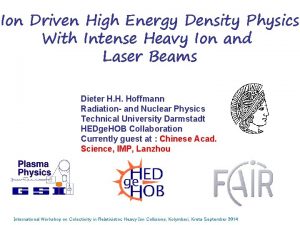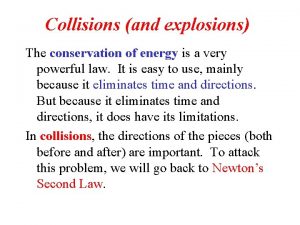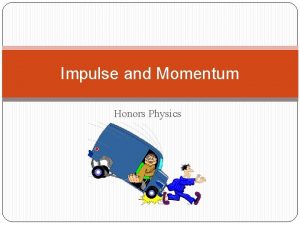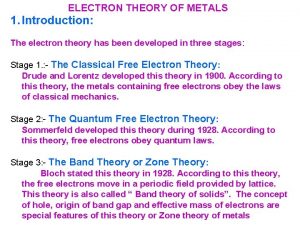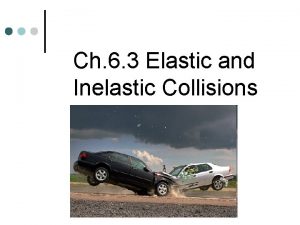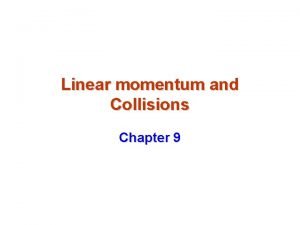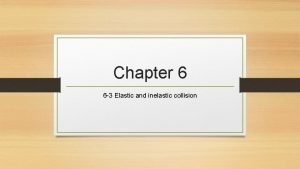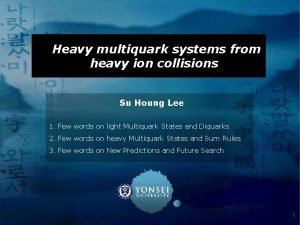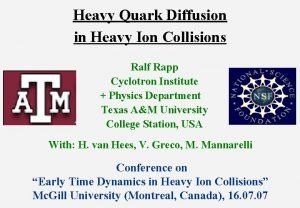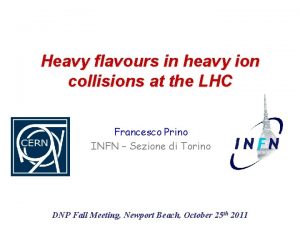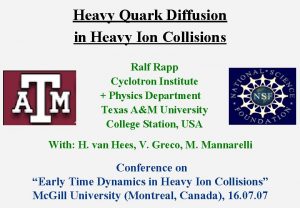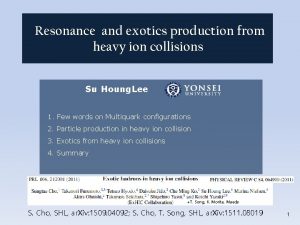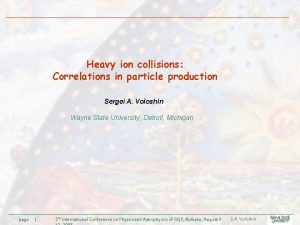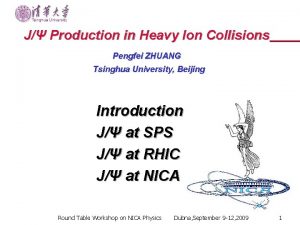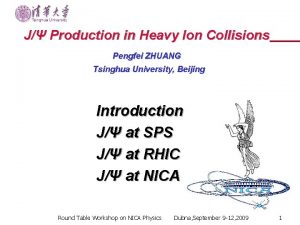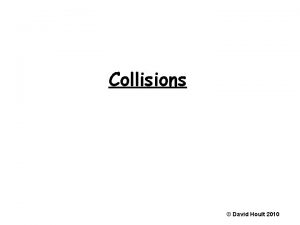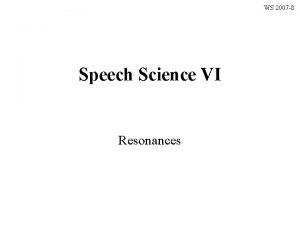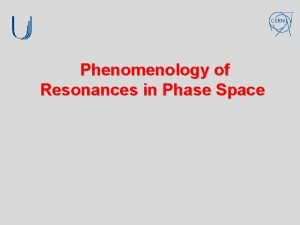Production of Resonances in Heavy Ion Collisions Christina

![space Resonances in Medium time Au+Au Life-time [fm/c] : ++ = 1. 7 K(892) space Resonances in Medium time Au+Au Life-time [fm/c] : ++ = 1. 7 K(892)](https://slidetodoc.com/presentation_image_h2/9d5f617546978da505217af3104a354f/image-2.jpg)




![Rescattering and Regeneration Ur. QMD [2] Thermal model [1]: T = 177 Me. V Rescattering and Regeneration Ur. QMD [2] Thermal model [1]: T = 177 Me. V](https://slidetodoc.com/presentation_image_h2/9d5f617546978da505217af3104a354f/image-7.jpg)






- Slides: 13

Production of Resonances in Heavy Ion Collisions Christina Markert, Yale University Resonances in Medium Rescattering and Regeneration Time Scale Contribution to Particle Yields Conclusions Christina Markert SQM 2004, Cape Town 1
![space Resonances in Medium time AuAu Lifetime fmc 1 7 K892 space Resonances in Medium time Au+Au Life-time [fm/c] : ++ = 1. 7 K(892)](https://slidetodoc.com/presentation_image_h2/9d5f617546978da505217af3104a354f/image-2.jpg)
space Resonances in Medium time Au+Au Life-time [fm/c] : ++ = 1. 7 K(892) = 4 S(1385) = 5. 7 (1520) = 13 (1020) = 44 Kp+ K* Hadronization Chemical freeze-out Rescattering/regeneration Thermal freeze-out Christina Markert SQM 2004, Cape Town Measurements: Leptonic and hadronic channels: e. g. e++e-, m++m- , K++KCollision systems: p+p and A+A collisions 2

Δ++ STAR preliminary 30 -50% Au+Au Δ++ Width Ge. V/c 2 Resonance in dense Matter s. NN = 200 Ge. V STAR Preliminary Au. Au PDG Minv p+p+ [Ge. V/c 2] d. Nch/dη p+nucleon propagation in medium + fireball conditions (T, r ) D(1232) from: Tkin=100 Me. V D(1232) width increase Christina Markert SQM 2004, Cape Town Hendrik von Hees: Hot. Quarks 2004 (Hees and Rapp nucl-th/0407050) Medium Modifications of the Delta Resonance at RHIC 3

Meson at SPS and RHIC Talks at this conference: A. Marin : New results from CERES in K++K- and e++e(Talk on Sunday) M. Kaneta : PHENIX in d+Au (future Au+Au) s. NN = 200 Ge. V d+Au, Min. Bias 10 -1 10 -2 PHENIX preliminary stat. err. only e+ e K+ K- 10 -3 10 -4 Hadronic channel: less signal in low pt lower yield (factor 2 -4) Christina Markert 10 -5 0 0. 5 1 1. 5 2 2. 5 3 m. T – mass [Ge. V/c 2] SQM 2004, Cape Town 4

Hadronic Phase after Chemical Freeze-out signal loss in low momentum region Increase of inverse slope Ur. QMD: signal loss in invariant mass reconstruction due to rescattering of decay daughters K*(892) (1520) SPS (17 Ge. V) 66% 50% 26% RHIC (200 Ge. V) 55% 30% 23% • Signal loss in Ur. QMD = 26% • Data: yield factor of 2 -4 difference for hadronic to leptonic channel. • Additional in medium modification of resonance at early stage ? Ur. QMD: Marcus Bleicher and Jörg Aichelin Phys. Lett. B 530 (2002) 81. M. Bleicher and Horst Stöcker. Phys. G 30 (2004) 111. Christina Markert SQM 2004, Cape Town Theory describes data with: • In-medium kaon potential • Rescattering of secondary kaons width of = 30 Me. V (Vacuum 4. 5 Me. V) life time of fireball = 20 fm/c E. Kolomeitsev, SQM 2001 J. Phys. G 28: 1697 -1706, 2002 5

Statistical Model for Particle Production in Au+Au Collisions STAR Preliminary Resonance ratios in Au+Au are not are well described with Tch = 160 10 Me. V, m. B = 24 5 Me. V (QM 2004 Olga Barannikova) Christina Markert SQM 2004, Cape Town 6
![Rescattering and Regeneration Ur QMD 2 Thermal model 1 T 177 Me V Rescattering and Regeneration Ur. QMD [2] Thermal model [1]: T = 177 Me. V](https://slidetodoc.com/presentation_image_h2/9d5f617546978da505217af3104a354f/image-7.jpg)
Rescattering and Regeneration Ur. QMD [2] Thermal model [1]: T = 177 Me. V m. B = 29 Me. V Life-time [fm/c] : ++ = 1. 7 K(892) = 4 S(1385) = 5. 7 (1520) = 13 (1020) = 44 K* rescattering > regeneration D++ regeneration > rescattering S* similar to D++ , baryon+meson L* rescattering > regeneration no regeneration with p Regeneration cross section: s(k+p) < s (p+p), s ( +p) ? L* K* D++ S* Christina Markert SQM 2004, Cape Town [1] P. Braun-Munzinger et. al. , PLB 518(2001) 41 D. Magestro, private communication [2] Marcus Bleicher and Jörg Aichelin Phys. Lett. B 530 (2002) 81. M. Bleicher and Horst Stöcker J. Phys. G 30 (2004) 111. 7

Signal Loss in low p. T Region D p. T Ur. QMD ++(1232) 100 Me. V K(892) 140 Me. V (1020) 35 Me. V Inverse slope increase from p+p to Au+Au collisions. Ur. QMD predicts signal loss at low p. T due to rescattering of decay daughters. Inverse slopes and mean p. T are higher. Ur. QMD has long lifetime (Dt 5 -20 fm/c) Christina Markert SQM 2004, Cape Town 8

Particle spectra from Thermal Model W. Florkowski, this conference Christina Markert SQM 2004, Cape Town Signal loss for K* in low momentum region due to rescattering 9

Temperature and “Life-time” from K* and L* (STAR) G. Torrieri and J. Rafelski, Phys. Lett. B 509 (2001) 239 Life time: K(892) = 4 fm/c (1520) = 13 fm/c Model includes: • Temperature at chemical freeze-out • “Life-time” between chemical and thermal freeze-out • By comparing two particle ratios (no regeneration) results between : T= 160 Me. V => > 4 fm/c (lower limit !!!) = 0 fm/c => T= 110 -130 Me. V (1520)/ = 0. 034 0. 011 0. 013 Does not work for S*, D++, (STAR) K*/K- = 0. 20 0. 03 at 0 -10% most central Au+Au Christina Markert SQM 2004, Cape Town 10

Temperature, “Life-time” from Particle Spectra p, K and p Tch freeze-out Tkin freeze-out Tch from Thermal model, Tkin and b from Blast-Wave-Fit to p, K and p Hhh ff t (Tch /Tkin – 1) R/b “Life-time” nearly constant in peripheral and central Au+Au collisions Go to smaller systems volume “Life-time” d+Au , Si+Si , Cu+Cu Christina Markert SQM 2004, Cape Town 11

Feed down from Resonances J. Letessier, J. Rafelski, Hadrons and Quark Gluon Plasma, Cambridge Monographs S* STAR direct Thermal model+STAR data Tch=160 Me. V 32% primary Lambdas 26% primary Protons Christina Markert SQM 2004, Cape Town direct X+ W Lambdas S 0 direct S 0 Talk by G. Van Buren at this conference Delta Rescattering and regeneration Less primary particles Momentum distribution changes Protons Lambda Large fraction of stable particles come from resonance decays. % of total yield Tch = 160 Me. V S* S 0 12

Conclusions • Strong interacting hadronic medium after chemical freeze-out. Thermal models do not describe all resonance yields. Rescattering and regeneration of resonances. Regeneration probes hadronic cross sections of heavy baryons. “Life-time” between freeze-outs > 4 fm/c • Medium modification of resonances. Width broadening of D++ observed at RHIC energies in Au+Au collisions medium modification. yield in leptonic and hadronic channel at SPS give indication of width broadening of phi in medium. • Large fraction of particles coming from resonance decays Could affect kinematics of ’primordial’ particles. Christina Markert SQM 2004, Cape Town 13
 Memasarkan produk multimedia termasuk dalam proses produksi
Memasarkan produk multimedia termasuk dalam proses produksi Ratey rational functions
Ratey rational functions Heavy ion
Heavy ion London forces
London forces Ion dipolo
Ion dipolo Ejemplo de fuerza ion ion
Ejemplo de fuerza ion ion Que son fuerzas intramoleculares
Que son fuerzas intramoleculares Collisions and explosions
Collisions and explosions Relationship between momentum and impulse
Relationship between momentum and impulse Drawbacks of free electron theory
Drawbacks of free electron theory Inelastic collision examples real world
Inelastic collision examples real world A freight train is being assembled in a switching yard
A freight train is being assembled in a switching yard Combined velocity after collision formula
Combined velocity after collision formula Types of collision
Types of collision


